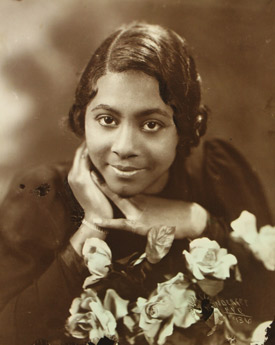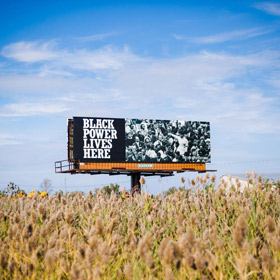Depression and Diversity
John Haberin New York City
Harold Haliday Costain, James van der Zee, and For Freedoms
The Great Depression was a crisis, but at least Americans could face it together. At least it may seem so in memory, as long as one forgets Jim Crow and resistance on the right.
So it may seem to partisans eager for a model of progressive leadership now, as with the Green New Deal. So it appears, too, in photographs by Harold Haliday Costain in salt mines and factories and by James van der Zee on the far side of a racial divide, in Harlem. Now a prominent African American artist and For Freedoms look for a model, too, in the whitest of American artists, Norman Rockwell.  They just happen to look beyond leaders to diversity and collective action. Where the New Deal paid for a renewed physical infrastructure, they call for one in art. Do they have a chance?
They just happen to look beyond leaders to diversity and collective action. Where the New Deal paid for a renewed physical infrastructure, they call for one in art. Do they have a chance?
Sugar and spice
In 1934, in the depths of the Depression, Harold Haliday Costain went to the work. He also sought workers out. He photographed them sifting, sorting, stacking, and shipping in Louisiana, in New Jersey, and right here in New York, in Long Island City. He erred on the side of long titles, too, so that one knows exactly what the workers were doing. These may be tough times, they say, but tough people are still at it. And the future belongs to them—except when it did not.
Costain was not a photojournalist, a social chronicler like August Sander, or a reformer like Walker Evans. He was not an art photographer either, not by profession, although his view of a spiral staircase recalls Paris for Henri Cartier-Bresson just three years before him. A gallery calls his show "Sugar & Salt," but not in the sense of a sweeter America or the salt of the earth. Costain worked on commission, for Fortune magazine in the salt mines and for the National Sugar Refining Company the very next year, and he had no qualms about serving corporate needs by cleaning up his act. Workers on the assembly line look unharried. A man beside towering bags of sugar stands at ease.
The gallery speaks of the work as pristine, and Costain loves strong light, so that the wall of sugar seems to glow. His angled, off-center compositions show the influence of early Modernism, approaching still life for Giorgio Morandi or abstract murals for the Works Progress Administration in much the same years. A commercial photographer in his thirties, with a studio in a New York suburb, he had to find his own invention of abstraction. He had a populist sensibility all the same. Other stacks look not so very far from Brillo boxes for Andy Warhol. Not that either man would relish the comparison, but they fed the same yearning for a common experience apart from art.
All, though, is not sugar and spice, for all the toughness. Machinery in a worker's hands seems to be crumbling before one's eyes. When people step out of the picture, the interiors look downright spooky. And when Costain leaves the factories behind, the bow of a cargo ship in silhouette looks ominous. His employment has left him mostly out of the history books, although he lived well into his nineties. I look forward to a look beyond these two years to see where photography took him.
For Costain, an individual was not just heroic but triumphant, even in the grip of repetitive labor. One might say the same for something that his America did its best in the 1930s to marginalize and to forget—black lives in the inner city. James van der Zee had little need for heroes, not even jazz legends, although he photographed a lightweight boxer posed for a fight. All he asked was style, and for him style was a matter not of luxury goods but of everyday life—which for Consuelo Kanaga in Harlem meant everyday heroes. If he could lend anyone style, so be it. His subjects would have wanted it that way.
One can never get through a display of photography at the Studio Museum in Harlem without a healthy sample of his work or a heavy dose of nostalgia. One cannot look at soldiers in a parade without wanting to march with them—and not just in solidarity against racism. One cannot look at pristine storefronts and restaurants in the Harlem Renaissance without wanting to move right in. Whites could almost imagine finding a welcome at that, and van der Zee includes them, too, like Winold Reiss in painting then and Jamel Shabazz in Harlem today. A selection sets his portrait photography apart from his more typical portraits of the community to ask what gave them their style.
People here have not left the studio, but they still seem at home, like a white woman treasuring an overflowing bouquet of roses or a black woman with her dog, as Her Best Friend. van der Zee also relied on painted backdrops and hand-tinted prints for a touch of theater, and his sitters include a man at a piano and a child breaking into a dance. Mostly, though, they just bring what matters most to their sense of themselves. One remembers a parade of hats, suits, bridal dresses, curled hair, and uniforms along with the pets and flowers, although one woman poses nude. The nostalgia may paper over the greater achievement of black culture, the subject for Roy DeCarava, and a still greater oppression. Still, where a recent show of African American portraits at the Met stressed their anonymity, this one roots their awkwardness and sophistication in a time and a place.
You Too
Poll Americans today by gender, race, class, age, religion (evangelicals and not), or almost any significant issue and you will see a nation divided. Who, then, are we the people, and can we find ourselves by looking to the past? Nari Ward asks when he fashions those words from laces for sneakers, only to see them unravel. For advocates of Black Lives Matter and #MeToo, those divisions appear not just on election day at that, but as matters of everyday dignity and survival. Yet the For Freedoms collective sees grounds for hope, enough to ask about a collective future: as the International Center of Photography has it, "Where Do We Go from Here?"
It sees hope in numbers alone—a million Internet hits, four million posters, and above all a fifty-state initiative. Those numbers add up to a compact history of the collective. Hank Willis Thomas and Eric Gottesman founded it in 2016, with the goal of "building an arts infrastructure." But can art alone heal the divisions? Maybe not, but the initiative has taken over billboards across America, with an assist from Theaster Gates. A packed wall at ICP displays their twofold strategy—of terse and often biting text, plus snapshots of the landscape in each state, all from hundreds of artists.
 Already one can see divisions that will not so easily go away, only starting with the sunshine of open air and the dark night of words. Here we stands not for unity but diversity, and where can we go from here? If the question looks more formidable than ever, the show wants you to help with answers, in the plural. Another wall offers space for Post-its, and a third has posters with space for visitors to enter their desired freedom. Even that takes into account tensions and multiplicity, for the blank space can complete freedom for, freedom of, freedom to, or freedom from. That very choice divides the country—between conservatives demanding freedom from government or outsiders and liberals demanding the opportunity of for, of, and to.
Already one can see divisions that will not so easily go away, only starting with the sunshine of open air and the dark night of words. Here we stands not for unity but diversity, and where can we go from here? If the question looks more formidable than ever, the show wants you to help with answers, in the plural. Another wall offers space for Post-its, and a third has posters with space for visitors to enter their desired freedom. Even that takes into account tensions and multiplicity, for the blank space can complete freedom for, freedom of, freedom to, or freedom from. That very choice divides the country—between conservatives demanding freedom from government or outsiders and liberals demanding the opportunity of for, of, and to.
Just to ask about freedom for all amounts to optimism, and the name For Freedoms puns on a time when more of America was united. The Works Progress Administration had been funding artists during the Great Depression, from photographers like Walker Evans to abstract painters like Lee Krasner, and the president was delighted to enlist art more directly in the cause of freedom. FDR introduced the idea of four freedoms in his 1941 State of the Union address, and Norman Rockwell translated them into four popular posters for The Saturday Evening Post in 1943—Freedom of Speech, Freedom of Worship, Freedom from Want, and Freedom from Fear. You would recognize them instantly. The government turned out millions of copies and enlisted them to sell war bonds.
Do they still make sense, now that a different kind of war is going on for the heart of the country? For Thomas, they just need a little updating. He and Emil Shur produced four photographs to do the job, and such details as wallpaper (added digitally) recall the originals, but the cast is anything but lily white. Henry Fonda might well have played Rockwell's working-class male calling for freedom of speech, and those praying for freedom of worship look right out of Trump country. The new versions include a Muslim among those praying and an impeccable spectrum around the Thanksgiving dinner table freed from want. Even the family putting a child to sleep without fear is racially mixed.
Is the result, curated by Ava Hess, too upbeat and cloying by half? You bet, but the collective's billboard under the Brooklyn Bridge will not back away from the task ahead. Its photograph by Gordon Parks and text from a project of his, "I Am You," take care of the we, but with a clear challenge to you. Then, too, the photo shows the March on Washington for Jobs and Freedom in 1963. That gathering was a high-water mark when it comes to hope, but the right's injection of race into politics was only just getting underway. The questions and initiatives remain open.

Harold Haliday Costain ran at Keith de Lellis through January 26, 2019, James van der Zee at Howard Greenberg through April 27, and For Freedoms at the International Center of Photography through April 28.




